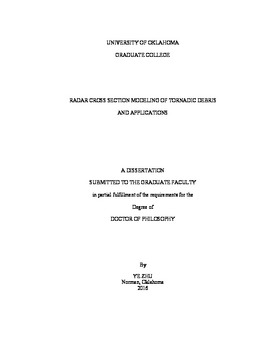| dc.description.abstract | Tornadic debris plays an important role in the study of tornadoes due to the dramatic threat it poses to human life, and the devastation it causes to commercial and residential property. Radar cross section (RCS) modeling on plate-like and cylindrical objects is developed in this tornadic debris study. The sheets, plates, and cylinders used in this study are designed to represent leaves, wood board, flat building forms, metal rods, tree trunks, and branches, respectively.
Different techniques are evaluated in terms of the geometry of the object, accuracy, and math complexity and computation efficiency. Geometrical Optics (GO), Geometrical Theory of Diffraction (GTD), Finite Element Method (FEM), Finite Difference Time Domain method (FDTD), Moment of Method (MoM) and Physical Optics (PO) are introduced. Finally, the decision to use PO for deriving the formulation for plate-like objects throughout the dissertation was made.
Non-metal objects such as cylinder broadside, endcap, general circular sheets and plates, surface impedance circular plates, rectangular sheets and plates, as well as metal circular plates are derived by hand. Metal objects such as cylinder broadside and rectangular plates, as well as resistive rectangular thin sheet approximations, are verified and cited from published research books and papers.
Full wave simulation Ansys HFSS validates the analytical results in most cases. FEKO commercial software is used to compare the analytical results for two layer plates with different media and leaf sample applications.
After testing, metal vs. non-metal plates and thin vs. thick plates are distinguished by 5 dB, 10 dB, and 20 dB from the simulation results, respectively; this fact confirms the accuracy and limitations of theory. By adding endcaps, one is able to compensate the deficiency from normal to the cap surface of the finite cylinder by at least several wavelengths in length and at least half of a wavelength in radius. The theoretical analysis of the extension of PO indicates that more accurate results appear as the incident angle gets closer to normal. The errors and limitations of PO are described and demonstrated by comparison plots of analytical results vs. HFSS throughout.
The leaf library and wood board (dry and wet) studies are performed as sample applications for “real” debris types under the radar coordinate transformation system for all polarizations at oblique TEM incident wave.
Research questions are answered in the conclusions. | en_US |
